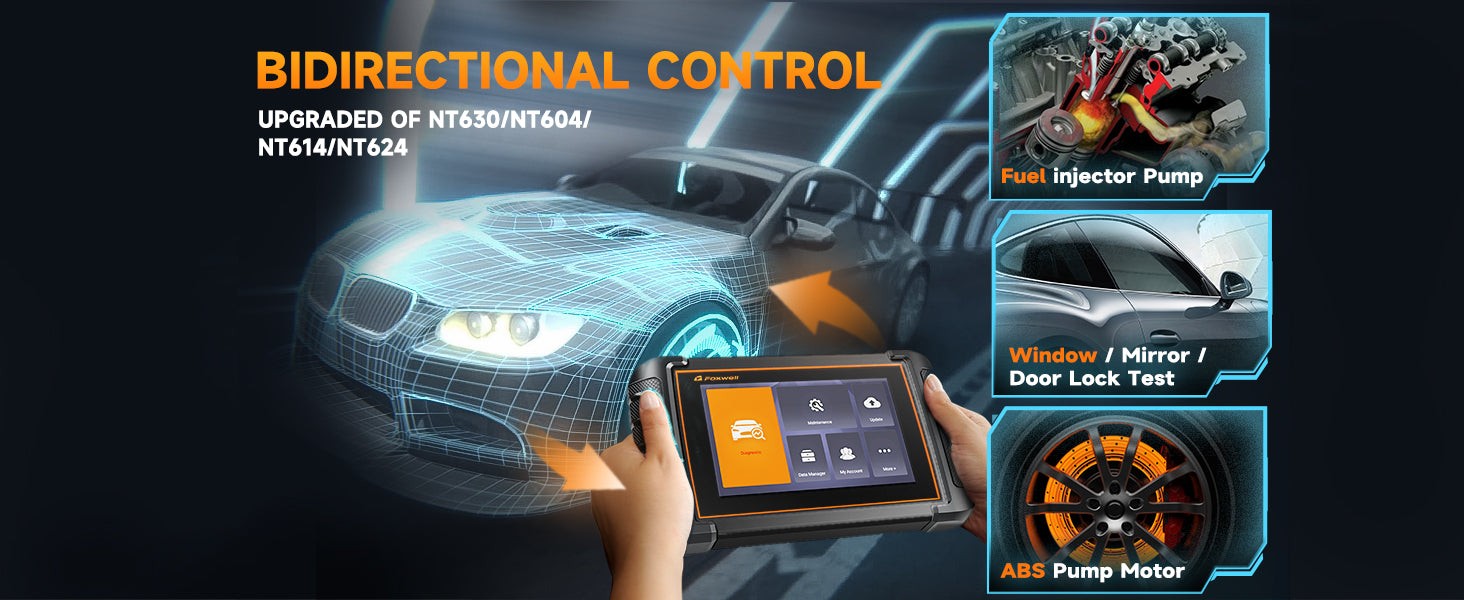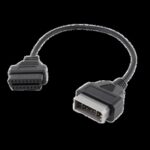Automotive maintenance and safety are significantly enhanced by two key technologies: OBD2 diagnostic scanners and Tire Pressure Monitoring Systems (TPMS). Both are crucial for vehicle safety but serve different purposes. This article will explore their roles and address the question of whether an OBD2 reader can show tire pressure sensor information, clarifying why specialized TPMS tools are often necessary.
Understanding Tire Pressure Monitoring Systems (TPMS) and Their Importance
Tire Pressure Monitoring Systems (TPMS) are automated safety features that monitor the air pressure within your vehicle’s tires. These systems provide real-time tire pressure data to drivers, typically displayed on a dashboard gauge, a pictogram, or via a low-pressure warning light. This immediate feedback is vital for maintaining optimal vehicle performance, fuel efficiency, and, most importantly, safety.
A properly functioning TPMS is not just about convenience; it’s a critical safety component. Maintaining correct tire pressure is essential because it directly influences a vehicle’s handling, efficiency, and overall safety on the road.
Why Tire Pressure Monitoring Systems are Crucial for Vehicle Safety
Maintaining optimal tire pressure extends beyond tire longevity and fuel economy; it’s a fundamental safety practice. Driving with under-inflated tires can have serious safety implications:
Reduced Steering and Handling: Low tire pressure can severely impair a vehicle’s handling, making steering more difficult, especially at high speeds or in emergency situations. This reduced responsiveness can increase the risk of accidents.
Increased Risk of Tire Failure: Under-inflated tires flex more, generating excessive heat. This heat buildup can lead to tire blowouts, which are dangerous and can cause loss of vehicle control, potentially leading to severe accidents.
Extended Stopping Distances: Vehicles with improperly inflated tires require longer distances to come to a complete stop. This is particularly hazardous in sudden stop-and-go traffic or emergency braking situations, increasing the likelihood of collisions.
By continuously monitoring tire pressure, TPMS acts as an early warning system, alerting drivers to potential tire pressure problems before they escalate. This proactive approach is essential for preventing accidents and enhancing road safety for everyone.
For comprehensive vehicle maintenance, understanding your car’s tools, from OBD2 scanners to TPMS, is essential. A common question among car owners and technicians is: “Will an OBD2 reader show tire pressure sensors?” To answer this, we must examine the capabilities of standard OBD2 scanners and understand why specialized tools are often required for TPMS-related tasks, especially resetting. Let’s delve into the general functions of OBD2 scanners and why dedicated TPMS tools are frequently necessary.
Standard OBD2 Scanner Capabilities in Relation to TPMS
OBD2 scanners are primarily designed to read and clear diagnostic trouble codes (DTCs) related to a vehicle’s engine and emission control systems. They provide valuable insights into engine health and the status of related systems, which may include basic tire pressure monitoring information.
Beyond engine diagnostics, OBD2 scanners can access diagnostic data from other vehicle systems, potentially offering limited information on components like brake pads and, in some cases, tire pressure.
Engine Diagnostics Focus: Standard OBD2 scanners excel at identifying engine-related issues, such as problems with combustion, emissions, or sensor malfunctions. They are indispensable tools for diagnosing engine performance and emission problems.
Generic Code Reading and Resetting: These scanners can read and reset generic diagnostic trouble codes (DTCs) that are standardized across most vehicles. This capability is crucial for basic diagnostics and maintenance.
However, TPMS issues often generate manufacturer-specific codes that are not accessible or interpretable by basic OBD2 scanners. While OBD2 scanners might show a general TPMS fault code, they typically lack the ability to provide detailed information or perform specific TPMS functions.
Although OBD2 scanners may offer features beyond engine diagnostics, including reading data from body control and chassis control modules, their capabilities regarding TPMS are generally limited. This limitation is significant when dealing with TPMS resets or more in-depth diagnostics.
Why Specialized Scanners Are Often Necessary for TPMS Reset and Functionality
Resetting and programming Tire Pressure Monitoring Systems (TPMS) often requires specialized functionalities that are beyond the scope of generic OBD2 scanners. This is why dedicated TPMS scanners are frequently necessary for effective TPMS management. Here’s why specialized scanners are often indispensable:
Manufacturer-Specific Communication Protocols: TPMS modules communicate using protocols that are often unique to each vehicle manufacturer. Generic OBD2 scanners are not equipped to understand these proprietary protocols, limiting their ability to interact with TPMS modules effectively. Specialized scanners, on the other hand, are designed to recognize and communicate using these specific protocols.
Advanced TPMS Functionality Requirements: TPMS reset procedures can involve more than just clearing codes. They may require sensor reconfiguration, sensor ID relearning, or even sensor programming, especially after tire rotation or sensor replacement. Standard OBD2 scanners generally lack these advanced functionalities.
Integrated TPMS-Specific Features: Dedicated TPMS scanners come with integrated features designed for comprehensive TPMS maintenance. These features can include sensor programming, TPMS health checks, and real-time sensor data displays. Such specialized functionalities are not found in standard OBD2 scanners, making TPMS-specific tools essential for thorough TPMS service.
Key Features of TPMS-Specific Scanners
When it comes to managing Tire Pressure Monitoring Systems (TPMS), having the right diagnostic tool is paramount. Since standard OBD2 scanners often lack the necessary capabilities for reprogramming or resetting TPMS, TPMS-specific scanners become vital for anyone needing comprehensive interaction with these systems.
Let’s examine the differences between general OBD2 scanners and tools specifically designed for TPMS, highlighting the crucial features to look for in a scanner capable of effectively resetting or reprogramming TPMS. We will also explore relevant Foxwell models that offer these capabilities.
OBD2 Scanners: Limited TPMS Capabilities: General OBD2 scanners are primarily designed for engine and emission-related diagnostics. While they may read generic TPMS fault codes within the OBD2 system, they typically cannot reset or reprogram TPMS modules. Their TPMS functionality is limited to basic fault code reading.
TPMS-Specific Tools: Enhanced TPMS Functionality: In contrast, TPMS-specific scanners are engineered to interface directly with a vehicle’s TPMS. They offer advanced functions such as TPMS resetting, sensor programming, and even sensor replacement support. These tools provide direct communication with the TPMS module, enabling detailed diagnostics and access to sensor data.
Essential Features in a TPMS-Specific Scanner
When selecting a TPMS-specific scanner, several features are particularly important:
Broad Sensor Compatibility: Ensure the scanner is compatible with a wide range of TPMS sensors. Compatibility can vary significantly across different vehicle makes and models, so broad compatibility is crucial for versatility.
Sensor Programming Capability: The ability to program new sensors is vital, especially when replacing old sensors or when switching between tire sets (like summer and winter tires). A scanner with robust sensor programming features simplifies sensor replacement and management.
TPMS Reset and Relearn Procedures: Look for scanners that offer straightforward reset options and guided relearn procedures for TPMS sensors. These features are essential after sensor replacement, tire rotation, or when tire pressures are adjusted. User-friendly reset and relearn processes save time and reduce complexity.
Live Sensor Data Monitoring: Advanced TPMS scanners should provide real-time data from each sensor, including pressure, temperature, and battery status. Live data monitoring is invaluable for accurate diagnostics, allowing technicians to monitor sensor performance and identify issues precisely. This real-time feedback enhances diagnostic accuracy and efficiency.
Foxwell Models Supporting TPMS Reset and Diagnostics
Foxwell offers several diagnostic tools that are excellent for TPMS management and resets, notably the Foxwell NT310 and Foxwell NT530 models. These tools are designed to meet the needs of both automotive professionals and car enthusiasts seeking reliable and accurate TPMS functionality.
Foxwell NT310 TPMS Universal Tool: The Foxwell NT310 is specifically tailored for TPMS tasks. It is equipped with features to trigger, program, and relearn TPMS sensors, as well as perform comprehensive TPMS diagnostic functions. Its focused design makes it an efficient tool for TPMS maintenance.
User-Friendly Interface: Designed with ease of use in mind, the NT310 features a straightforward interface that simplifies TPMS maintenance tasks. This user-friendliness makes it suitable for both beginners and experienced professionals, ensuring efficient operation for all users.
Foxwell NT530 Multi-System Scanner: Versatility and TPMS Capabilities: The Foxwell NT530 provides versatile diagnostic capabilities that extend beyond TPMS. It offers complete system diagnostics for various vehicle systems, including engines, ABS, airbags, and more. Importantly, it also includes advanced features for diagnosing and resetting TPMS quickly and effectively.
Vehicle-Specific Software for Enhanced Accuracy: A key advantage of the NT530 is its vehicle-specific software. This feature allows it to function like an OEM (Original Equipment Manufacturer) diagnostic tool across numerous brands, ensuring highly accurate TPMS resets and diagnostics. This vehicle-specific approach enhances diagnostic precision and reliability.
Advanced Bi-Directional Functions: The NT530 supports advanced bi-directional tests, enabling users to command vehicle components to perform specific functions. This invaluable feature aids in troubleshooting and validating repair solutions, making it a powerful tool for comprehensive diagnostics.
Shared Features of Foxwell NT310 and NT530: Both the NT310 and NT530 share essential attributes that make them ideal for TPMS work:
Direct TPMS Support: They both provide direct access to a vehicle’s TPMS sensors and modules, enabling effective monitoring and resetting of the TPMS system. This direct access ensures comprehensive TPMS management.
Extensive Vehicle Coverage: These scanners support a wide range of vehicle makes and models equipped with TPMS, making them versatile choices for diverse automotive service environments. Their broad compatibility makes them valuable in various settings.
Regular Software Updates: Foxwell provides regular software updates for both the NT310 and NT530. These updates ensure compatibility with the latest vehicle models and TPMS technologies, keeping the scanners current and effective.
Foxwell’s NT310 and NT530 models are indispensable tools in modern automotive diagnostics, particularly for Tire Pressure Monitoring Systems.
Conclusion
The Foxwell NT310 and NT530 scanners cater to different needs: the NT310 excels in focused TPMS tasks with a user-friendly design, while the NT530 offers comprehensive vehicle system diagnostics, including robust TPMS capabilities. Both models provide reliable and efficient TPMS maintenance solutions for both amateur and professional mechanics, making TPMS management more accessible and practical.
Equipped with direct TPMS support, vehicle-specific software, and the ability to perform a wide array of automotive diagnostic tasks, the NT310 and NT530 contribute significantly to vehicle safety and efficiency. Foxwell’s commitment to innovation and quality is evident in these models, which are designed to adapt to the ever-evolving demands of automotive technology. From routine maintenance to complex repairs, Foxwell tools offer the reliability and precision needed to keep today’s vehicles performing optimally.
FAQs
Can the Foxwell NT530 perform TPMS Resets?
Yes, the Foxwell NT530 is fully capable of performing TPMS resets as part of its comprehensive vehicle system diagnostic functions. It is an ideal tool for in-depth vehicle diagnostics, including TPMS management.
Is the Foxwell NT310 Suitable for Professional Use?
Yes, the Foxwell NT310 is highly suitable for professional use, especially for technicians specializing in tire and wheel services. Its primary functions, including TPMS triggering, programming, and sensor relearning, make it an invaluable asset for automotive repair shops and service departments.
Do Foxwell Scanners Include Updates for New Vehicle Models?
Yes, Foxwell regularly releases software updates for the NT310 and NT530 scanners. These updates ensure that the tools remain compatible with the latest vehicle models and advancements in automotive technologies, keeping them up-to-date and effective.

